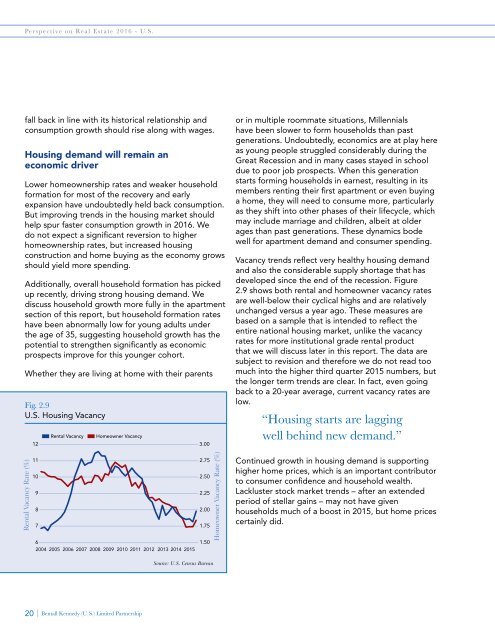BK Perspective Real Estate USA 2016
Create successful ePaper yourself
Turn your PDF publications into a flip-book with our unique Google optimized e-Paper software.
<strong>Perspective</strong> on <strong>Real</strong> <strong>Estate</strong> <strong>2016</strong> - U.S.<br />
fall back in line with its historical relationship and<br />
consumption growth should rise along with wages.<br />
Housing demand will remain an<br />
economic driver<br />
Lower homeownership rates and weaker household<br />
formation for most of the recovery and early<br />
expansion have undoubtedly held back consumption.<br />
But improving trends in the housing market should<br />
help spur faster consumption growth in <strong>2016</strong>. We<br />
do not expect a significant reversion to higher<br />
homeownership rates, but increased housing<br />
construction and home buying as the economy grows<br />
should yield more spending.<br />
Additionally, overall household formation has picked<br />
up recently, driving strong housing demand. We<br />
discuss household growth more fully in the apartment<br />
section of this report, but household formation rates<br />
have been abnormally low for young adults under<br />
the age of 35, suggesting household growth has the<br />
potential to strengthen significantly as economic<br />
prospects improve for this younger cohort.<br />
Whether they are living at home with their parents<br />
Fig. 2.9<br />
U.S. Housing Vacancy<br />
12<br />
Rental Vacancy<br />
Homeowner Vacancy<br />
3.00<br />
or in multiple roommate situations, Millennials<br />
have been slower to form households than past<br />
generations. Undoubtedly, economics are at play here<br />
as young people struggled considerably during the<br />
Great Recession and in many cases stayed in school<br />
due to poor job prospects. When this generation<br />
starts forming households in earnest, resulting in its<br />
members renting their first apartment or even buying<br />
a home, they will need to consume more, particularly<br />
as they shift into other phases of their lifecycle, which<br />
may include marriage and children, albeit at older<br />
ages than past generations. These dynamics bode<br />
well for apartment demand and consumer spending.<br />
Vacancy trends reflect very healthy housing demand<br />
and also the considerable supply shortage that has<br />
developed since the end of the recession. Figure<br />
2.9 shows both rental and homeowner vacancy rates<br />
are well-below their cyclical highs and are relatively<br />
unchanged versus a year ago. These measures are<br />
based on a sample that is intended to reflect the<br />
entire national housing market, unlike the vacancy<br />
rates for more institutional grade rental product<br />
that we will discuss later in this report. The data are<br />
subject to revision and therefore we do not read too<br />
much into the higher third quarter 2015 numbers, but<br />
the longer term trends are clear. In fact, even going<br />
back to a 20-year average, current vacancy rates are<br />
low.<br />
“Housing starts are lagging<br />
well behind new demand.”<br />
Rental Vacancy Rate (%)<br />
11<br />
10<br />
9<br />
8<br />
7<br />
6<br />
2004 2005 2006 2007 2008 2009 2010 2011 2012 2013 2014 2015<br />
2.75<br />
2.50<br />
2.25<br />
2.00<br />
1.75<br />
1.50<br />
Homeowner Vacancy Rate (%)<br />
Continued growth in housing demand is supporting<br />
higher home prices, which is an important contributor<br />
to consumer confidence and household wealth.<br />
Lackluster stock market trends – after an extended<br />
period of stellar gains – may not have given<br />
households much of a boost in 2015, but home prices<br />
certainly did.<br />
Source: U.S. Census Bureau<br />
20 | Bentall Kennedy (U.S.) Limited Partnership


